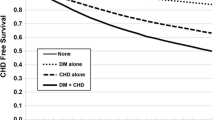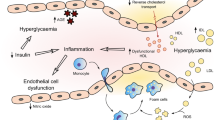Abstract
Purpose of Review
Individuals with diabetes mellitus (DM) have historically been reported to have the same risk of having a future myocardial infarction (MI) as an individual with known coronary heart disease (CHD). In other words, DM has been widely accepted as a coronary heart disease (CHD) equivalent. We review the literature that established DM as a CHD risk equivalent and how over time it has become clear that DM carries a spectrum of risk.
Recent Findings
Newer studies suggest that DM is heterogeneous, with certain subgroups such as women, those with longer duration of DM, and increased severity of disease may be more susceptible to downstream complications and cardiovascular events than those in other subgroups. The use of coronary artery calcium scoring for risk stratification in this group has now been shown to have clinical utility.
Summary
DM surely does infer increased risk of developing coronary heart disease upon an individual; however, this risk is not as high as historically presumed. Certain subgroups among the DM population may have a higher risk of CHD when identified by burden of subclinical disease; these individuals can be identified early to begin personalized management of their disease.
Similar content being viewed by others
References
Papers of particular interest, published recently, have been highlighted as: • Of importance •• Of major importance
• Centers for Disease Control and Prevention. National Diabetes Statistics Report, 2017. Atlanta: Centers for Disease Control and Prevention, U.S. Dept of Health and Human Services; 2017. This reference is a periodic publication from the Centers for Disease Control and Prevention (CDC) that provides updated statistics about diabetes in the USA for a scientific audience. The estimates in this document were derived from various data systems of CDC, including the Indian Health Service (IHS), the Agency for Healthcare Research and Quality (AHRQ), the U.S. Census Bureau, and published studies. The estimated percentages and the total number of people with diabetes and prediabetes were derived from the National Health and Nutrition Examination Survey (NHANES), National Health Interview Survey (NHIS), IHS National Data Warehouse (NDW), Behavioral Risk Factor Surveillance System (BRFSS), United States Diabetes Surveillance System (USDSS), and US resident population estimates. This reference was used in establishing the current statistics of diabetes and its current burden in the USA. This provided a framework for understanding the prevalence of heart disease amongst diabetics. This allowed for the further discussion of CHD equivalence in the context of a large and growing population established in the USA.
Haffner SM, Lehto S, Ronnemaa T, Pyorala K, Laakso M. Mortality from coronary heart disease in subjects with type 2 diabetes and in non-diabetic subjects with and without prior myocardial infarction. N Engl J Med. 1998;339:229–34.
Pajunen P, Koukkunen H, Ketonen M, Jerkkola T, Immonen-Räihä P, Kärjä-Koskenkari P, et al. Myocardial infarction in diabetic and non-diabetic persons with and without prior myocardial infarction: the FINAMI study. Diabetologia. 2005;48:2519–24.
Natarajan S, Liao Y, Cao G, Lipsitz SR, McGee DL. Sex differences in risk for coronary heart disease mortality associated with diabetes and established coronary heart disease. Arch Intern Med. 2003;163:1735–40.
Natarajan S, Liao Y, Sinha D, Cao G, McGee DL, Lipsitz SR. Sex differences in the effect of diabetes duration on coronary heart disease mortality. Arch Intern Med. 2005;165:430–5.
Hu FB, Stampfer MJ, Solomon CG, Liu S, Willett WC, Speizer FE, et al. The impact of diabetes mellitus on mortality from all causes and coronary heart disease mortality in women: 20 years of follow-up. Arch Intern Med. 2001;161:1717–23.
Evans JM, Wang J, Morris AD. Comparison of cardiovascular risk between patients with type 2 diabetes and those who had myocardial infarction: cross-sectional and cohort studies. Br Med J. 2002;324:939–42.
Lotufo PA, Gaziano JM, Chae CU, Ajani UA, Moreno-John G, Buring JE, et al. Diabetes and all cause and coronary heart disease mortality among US male physicians. Arch Intern Med. 2001;161:242–7.
Vaccaro O, Eberly LE, Neaton JD, Yang L, Riccardi G, Stamler J. Impact of diabetes and previous myocardial infarction on long-term survival: 25-year mortality follow-up of primary screeners of the Multiple Risk Factor Intervention Trial. Arch Intern Med. 2004;164:1438–43.
Hu G, Jousilahti P, Qiao Q, Katoh S, Tuomilehto J. Sex differences in cardiovascular and total mortality among diabetic and non-diabetic individuals with and without history of myocardial infarction. Diabetologia. 2005;48:656–66.
Expert Panel on Detection, Evaluation, and Treatment of High Blood Cholesterol in Adults. Executive summary of the third report of the National Cholesterol Education Program (NCEP) expert panel on detection, evaluation, and treatment of high blood cholesterol in adults (adult treatment panel III). JAMA. 2001;285(19):2486–97.
Bulugahapitiya U, Siyambalapitiya S, Sithole J, Idris I. Is diabetes a coronary risk equivalent? Systematic review and meta-analysis. Diabet Med. 2009;26:142–8.
Wong ND. Is diabetes really a coronary heart disease risk equivalent? Cardiovasc Endocrinol. 2012;1:65–7.
Wannamethee SG, Shaper AG, Whincup PH, Lennon L, Sattar N. Impact of diabetes on cardiovascular disease risk and all-cause mortality in older men: influence of age at onset, diabetes duration, and established and novel risk factors. Arch Intern Med. 2011;171:404–10.
Daniels LB, Grady D, Mosca L, Collins P, Mitlak BH, Amewou-Atisso MG, et al. Raloxifene Use for the Heart (RUTH) trial investigators. Is diabetes mellitus a heart disease equivalent in women? Results from an international study of postmenopausal women in the Raloxifene Use for the Heart (RUTH) trial. Circ Cardiovasc Qual Outcomes. 2013;6:164–70.
Goff DC Jr, Lloyd-Jones DM, Bennett G, American College of Cardiology/American Heart Association Task Force on Practice Guidelines, et al. 2013 ACC/AHA guideline on the assessment of cardiovascular risk: a report of the American College of Cardiology/American Heart Association Task Force on Practice Guidelines. J Am Coll Cardiol. 2014;63(25 Pt B):2935–59.
Schramm TK, Gislason GH, Køber L, et al. Diabetes patients requiring glucose-lowering therapy and nondiabetics with a prior myocardial infarction carry the same cardiovascular risk: a population study of 3.3 million people. Circulation. 2008;117:1945–54.
•• Rana JS, Liu JY, Moffet HH, Jaffe M, Karter AJ. Diabetes and prior coronary heart disease are not necessarily risk equivalent for future coronary heart disease events. J Gen Intern Med. 2016;31:387–93. These authors and researchers from Kaiser Permanente Northern California health system and University of California, San Francisco, used data from the Kaiser Permanent Northern California to conduct a population-based prospective cohort analysis to revisit the concept of risk equivalence by comparing the risk of subsequent CHD events among individuals with or without history of diabetes or CHD in a large contemporary real-world cohort over a period of 10 years (2002 to 2011). They established four different groups of patients categorized by prevalence or absence of diabetes and coronary heart disease. They found evidence that not all individuals with diabetes should be unconditionally assumed to be a risk equivalent of those with prior CHD. In contrast, the concept of CHD equivalence of diabetes has been widely accepted and this was presented in support of particular sub-groups with diabetes being considered at higher risk than others.
Zhang Y, Hu G, Yuan Z, Chen L. Glycosylated hemoglobin in relationship to cardiovascular outcomes and death in patients with type 2 diabetes: a systematic review and meta-analysis. PLoS One. 2012;7(8):e42551.
Howard BV, Best LG, Galloway JM, Howard WJ, Jones K, Lee ET, et al. Coronary heart disease risk equivalence in diabetes depends on concomitant risk factors. Diabetes Care. 2006;29(2):391–7.
Malik S. Excess Risk of Stroke in Women: The Role of Diabetes Mellitus. Nat Rev Endocrinol. 2014;10:318–320.
Emerging Risk Factors Collaboration, Sarwar N, Gao P, et al. Diabetes mellitus, fasting blood glucose concentration, and risk of vascular disease: a collaborative meta-analysis of 102 prospective studies. Lancet. 2010;375:2215–22.
Barrett-Connor E. The Rancho Bernardo Study: 40 years studying why women have less heart disease than men and how diabetes modifies women’s usual cardiac protection. Glob Heart. 2013;8(2) https://doi.org/10.1016/j.gheart.2012.12.002.
Howard BV, Cowan LD, Go O, Welty TK, Robbins DC, Lee ET, et al. Adverse effects of diabetes on multiple cardiovascular disease risk factors in women. The Strong Heart Study. Diabetes Care. 1998;21:1258–65.
Hypertension in Diabetes Study (HDS). I. Prevalence of hypertension in newly presenting type 2 diabetic patients and the association with risk factors for cardiovascular and diabetic complications. J Hypertens. 1993;11:309–17.
Ford ES, Li C, Zhao G, Tsai J. Trends in obesity and abdominal obesity among adults in the United States from 1999–2008. Int J Obes. 2011;35:736–43.
Silverman MG, Blaha MJ, Budoff MJ, Rivera JJ, Raggi P, Shaw LJ, et al. Potential implications of coronary artery calcium testing for guiding aspirin use among asymptomatic individuals with diabetes. Diabetes Care. 2012;35:624–6.
Malik S, Budoff MJ, Katz R, Blumenthal RS, Bertoni AG, Nasir K, et al. Impact of subclinical atherosclerosis on cardiovascular disease events in individuals with metabolic syndrome and diabetes: the multi ethnic study of atherosclerosis. Diabetes Care. 2011;34:2285–90.
Raggi P, Cooil B, Ratti C, Callister TQ, Budoff M. Progression of coronary artery calcium and occurrence of myocardial infarction in patients with and without diabetes mellitus. Hypertension. 2005;46(1):238–43.
Raggi P, Shaw LJ, Berman DS, Callister TQ. Prognostic value of coronary artery calcium screening in subjects with and without diabetes. J Am Coll Cardiol. 2004;43(9):1663–9.
Malik S, Zhao Y, Budoff M, Nasir K, Blumenthal RS, Bertoni AG, et al. Coronary artery calcium score for long-term risk classification in individuals with type 2 diabetes and metabolic syndrome from the multi-ethnic study of atherosclerosis. JAMA Cardiol. 2017;2:1332–40. https://doi.org/10.1001/jamacardio.2017.4191.
Wackers FJ, Young LH, Inzucchi SE, et al. Detection of ischemia in asymptomatic diabetics investigators. Detection of silent myocardial ischemia in asymptomatic diabetic subjects: the DIAD study. Diabetes Care. 2004;27(8):1954–61.
Wong ND, Detrano RC, Diamond G, Rezayat C, Mahmoudi R, Chong EC, et al. Does coronary artery screening by electron beam computed tomography motivate potentially beneficial lifestyle behaviors? Am J Cardiol. 1996;78(11):1220–3.
Author information
Authors and Affiliations
Corresponding author
Ethics declarations
Conflict of Interest
Shaista Malik and Erum Iqbal Bajwa declare that they have no conflict of interest.
Human and Animal Rights and Informed Consent
This article does not contain any studies with human or animal subjects performed by any of the authors.
Additional information
This article is part of the Topical Collection on Novel and Emerging Risk Factors
Rights and permissions
About this article
Cite this article
Bajwa, E.I., Malik, S. Debunking the Myth of Diabetes Mellitus as Cardiovascular Disease Equivalent: What Took So Long?. Curr Cardiovasc Risk Rep 12, 20 (2018). https://doi.org/10.1007/s12170-018-0585-6
Published:
DOI: https://doi.org/10.1007/s12170-018-0585-6




